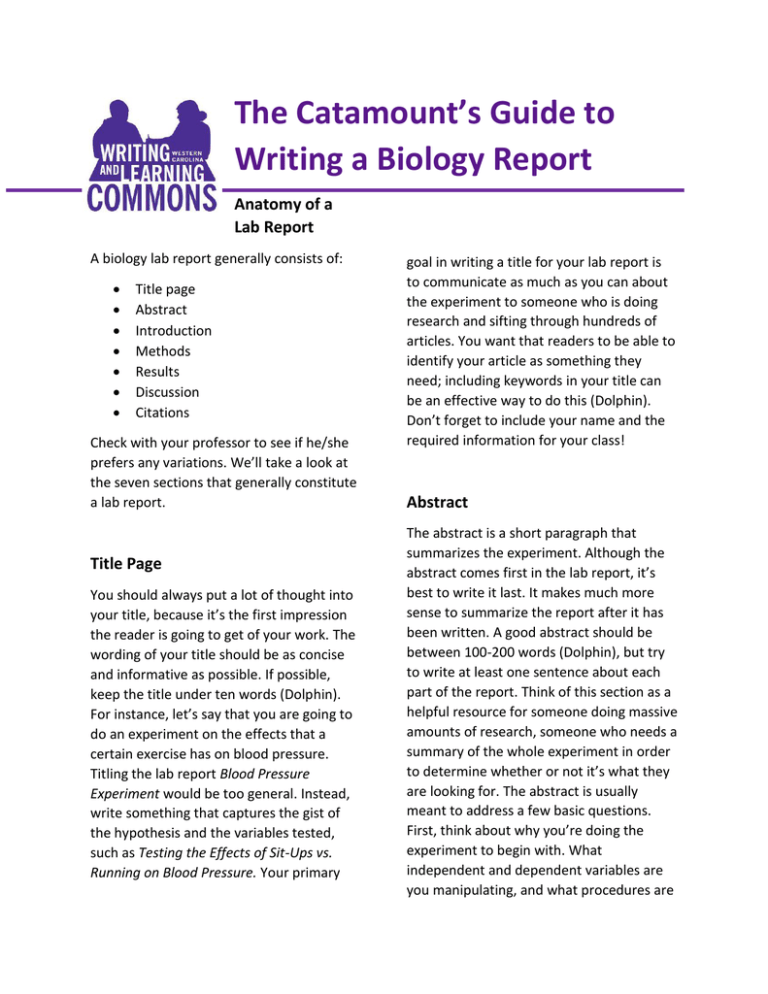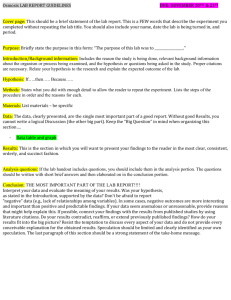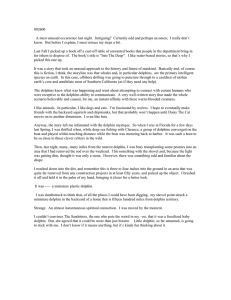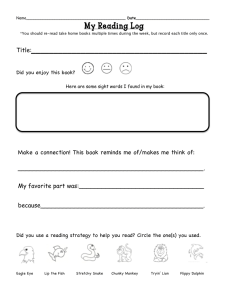The Catamount’s Guide to Writing a Biology Report Anatomy of a Lab Report
advertisement

The Catamount’s Guide to Writing a Biology Report Anatomy of a Lab Report A biology lab report generally consists of: Title page Abstract Introduction Methods Results Discussion Citations Check with your professor to see if he/she prefers any variations. We’ll take a look at the seven sections that generally constitute a lab report. Title Page You should always put a lot of thought into your title, because it’s the first impression the reader is going to get of your work. The wording of your title should be as concise and informative as possible. If possible, keep the title under ten words (Dolphin). For instance, let’s say that you are going to do an experiment on the effects that a certain exercise has on blood pressure. Titling the lab report Blood Pressure Experiment would be too general. Instead, write something that captures the gist of the hypothesis and the variables tested, such as Testing the Effects of Sit-Ups vs. Running on Blood Pressure. Your primary goal in writing a title for your lab report is to communicate as much as you can about the experiment to someone who is doing research and sifting through hundreds of articles. You want that readers to be able to identify your article as something they need; including keywords in your title can be an effective way to do this (Dolphin). Don’t forget to include your name and the required information for your class! Abstract The abstract is a short paragraph that summarizes the experiment. Although the abstract comes first in the lab report, it’s best to write it last. It makes much more sense to summarize the report after it has been written. A good abstract should be between 100-200 words (Dolphin), but try to write at least one sentence about each part of the report. Think of this section as a helpful resource for someone doing massive amounts of research, someone who needs a summary of the whole experiment in order to determine whether or not it’s what they are looking for. The abstract is usually meant to address a few basic questions. First, think about why you’re doing the experiment to begin with. What independent and dependent variables are you manipulating, and what procedures are being used to manipulate them? Next, focus on the results of your experiment. What raw data did you collect from this study? After that, tell the reader about the discussion and the major points of your conclusion (“Writing a Formal Lab Report”). Introduction In the introduction, you will discuss the question that this experiment is meant to address, as well as the means by which you plan to answer this question. You should try to answer these kinds of questions: Why did you perform this study? What scholarship is already out there? What is the specific purpose or aim of this study? (Dolphin) You will not describe the procedures of the experiment in too much detail (that will go in the methods section), but make sure that the reader has a clear understanding of how these experimental procedures are going to answer the question at hand (“Writing a Formal Lab Report”). Next, tell the reader how you believe this experiment will turn out, and list two sets of circumstances under which your hypothesis would be correct or incorrect. For example, you could say something like, “If my hypothesis is correct, I should expect… If my hypothesis is wrong, I should expect...” Methods The methods section is where you will describe your procedure in detail. First, you need to describe each of the materials you used in the experiment, along with their functions. Then, provide a detailed description of how your experiment was carried out. Clearly explain what was involved in each step of the procedure, keeping each of the events in order (“Writing a Formal Lab Report”). Keep in mind that this document is meant to be read by other scientists so that they can recreate your results, so strive for optimal clarity and completeness. If you are performing procedures exactly from another report, be sure to cite the work and note that there are additional details in that report (Dolphin). Results This section is reserved for a clear description of the results you obtained. Refrain from giving an interpretation of you results; that will come in the discussion section (“Writing a Formal Lab Report”). It should be an objective summary of your results. Some writers choose to organize their results section before organizing the rest of the report (Dolphin). You should use both text and figures to present your data. If you use graphs in this section, be sure that the axes are labeled. Carefully review your figures to ensure that they clearly address the problem that is being addressed in the experiment. Also, check to make sure that your graph is correct—you never know when Microsoft Excel might turn against you (“Writing a Formal Lab Report”). Discussion In the discussion, you will provide an interpretation of the results. How do these results answer the question that your experiment set out to address? Make it clear to the reader whether your hypothesis was supported or contradicted. If it turns out that your hypothesis was wrong, provide some explanation of why. You may also include outside research that pertains to your experiment. Sometimes the implications of your results aren’t immediately clear, so if this happens, you should explain what further experimentation could be done to clarify the issue (“Writing a Formal Lab Report”). It is also appropriate in this section to provide suggestions to improve the experiment in the future (Dolphin). Citations Throughout the paper, you should be using in-text citations to demonstrate when you have been using information from other sources (Cage). When you reach the end of your report, be sure to cite any sources you used throughout the paper in the style that your professor prefers. This will help you to avoid plagiarism. These should be articles, books, and other works that you directly cite in your report. Check with your journal or professor to determine which citation style is appropriate (Dolphin). Works Cited Cage, Molly and Jonathan Wakefield. “Writing Biology and Laboratory Reports.” Richmond University, n.d. Web. Dolphin, Warren D. “Writing Lab Reports and Scientific Papers.” McGraw-Hill College Division, 1997. Web. “Writing a Formal Lab Report.” Germanna Community College, n.d. Web.




